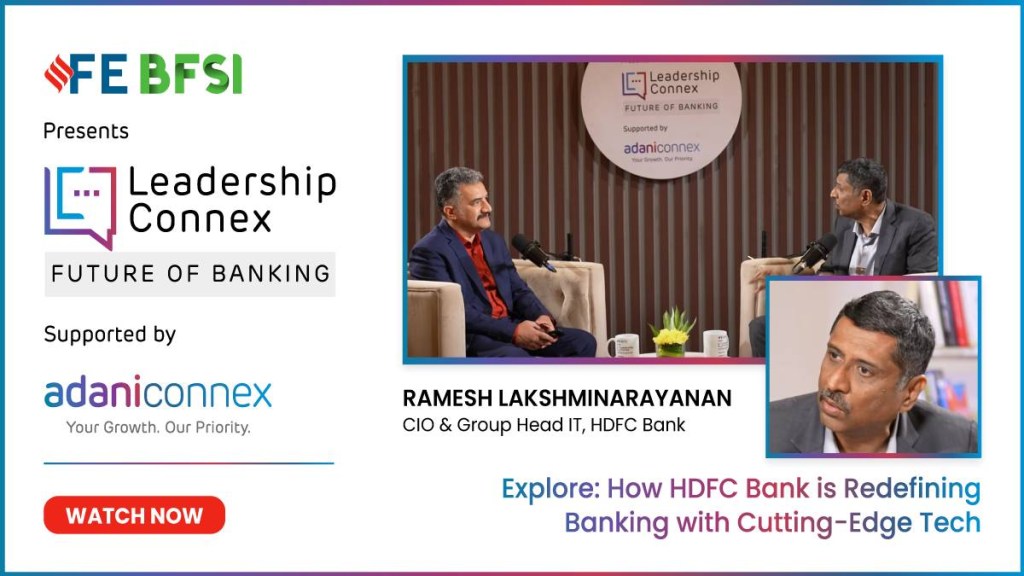In the age of the mobile phone, customers have become increasingly demanding, looking for everything at their fingertips – from shopping to banking. As Ramesh Lakshminarayanan, CIO and Group Head IT at HDFC Bank puts it, “Banks have to go where the customer is and not expect the customer to come to the bank. We are at a point where a lot of things are moving at a very fast pace. It’s a seminal moment for the country and banking is at the core of it.”
Speaking to Financial Express as part of the LeadershipConneX podcast series, he points out that the past five years have been amazing for India from a digital banking perspective, the coming of age of the digital public infrastructure, the fintech ecosystem, modernization of banks and democratization of credit. He says it’s interesting to see how banks are having to push the digitization agenda.
“Traditionally, we always used to think that banks would build mobile apps, build net banking and hope that customers would come to those properties. But now we compete heavily with new-age mobile apps with new technologies,” says Lakshminarayanan. Cloud technologies are at the centre of this new user experience and behaviour. But banks still have limitations and have to ensure their customers come to them. He adds: “The strategy is getting inverted. Today, we are seeing banks having to go where customers are transacting or customers are engaged – it’s a fundamental shift.”
He points out the example of how WhatsApp is a dominating app and hence banks like HDFC bank, need to tap customers on that platform. He says customers don’t want to use multiple apps for their transactions, so banks need to device ways to engage with the customer on the platform they are using.
Another example he points out: “Imagine an NRI sitting in the UK and using an
International Bank application, but he wants to send a remittance to somebody in India. He doesn’t want to log out and use another app. He wants to do it from that International Bank app. That’s what I mean when I say, banks have to go where the customer is already engaged and do not expect the customers to come to you.”
HDFC Bank, he says, is already doing this with Banking as a Service. He says for international banking transactions the bank has successfully integrated its API on different platforms like Remitly and Lulu Exchange. HDFC Bank is now looking to expand its WhatsApp Banking service – it is signing up customers at the rate of 35,000 a day, while the pace of mobile banking or net banking has slowed down.
Lakshminarayan sees the future of banking coming down to just one mobile app – a super app – which will be personalised. This is where AI and Gen AI will play a role across different parts of the banking ecosystem. Face to face interactions will reduce. Says Lakshminaryanan: “There are three buckets we look at for digital engagement. One is acquisition, the second is transaction and the third is servicing the customer. There is still an India that needs to be serviced through the assisted mode. It’s an India that is evolving. After a while the customer becomes unassisted and digital penetration is very high.”
He sees Gen AI driving the user experience itself. “There are 2-3 things that drive the digital experience because you start thinking like a fintech. One is the user experience. It may be a great-looking app, but may be very different experience for a rural guy, so you need a segmented digital experience,” he says. The second thing is the quality of the data the banks have – Gen AI will only work with the right data sets. The third is a proper API (application programming interface).
“AI is largely a left side brain kind of an activity when it’s analytical,” says Lakshminaryanan. Classical AI has been used for long in Banks’ fraud management and risk management. The next wave will be in driving hyper personalisation through AI by analysing customer accounts. “One of the things that banks have to do is enable data on the API layer, so when you fetch the balance in an account, you also fetch insights based on that data and push them together on the same channel to the customer,” he says. AI will also help relationship managers get to know their customers better, by providing summaries of each interaction.
Summing up he says, “We always used to think that core banking is at the centre of the banking universe right? I think that theory is actually out of the place. Data sits at the centre of your banking, but you have to start recognising the customer as the centre – not just a credit card customer or auto-loan customer.” Future bankers will need the right skills to read the data and interact with the customer on a personal level on the platform the customer chooses.
He signs off saying, “Gen AI will be a huge game changer.”

